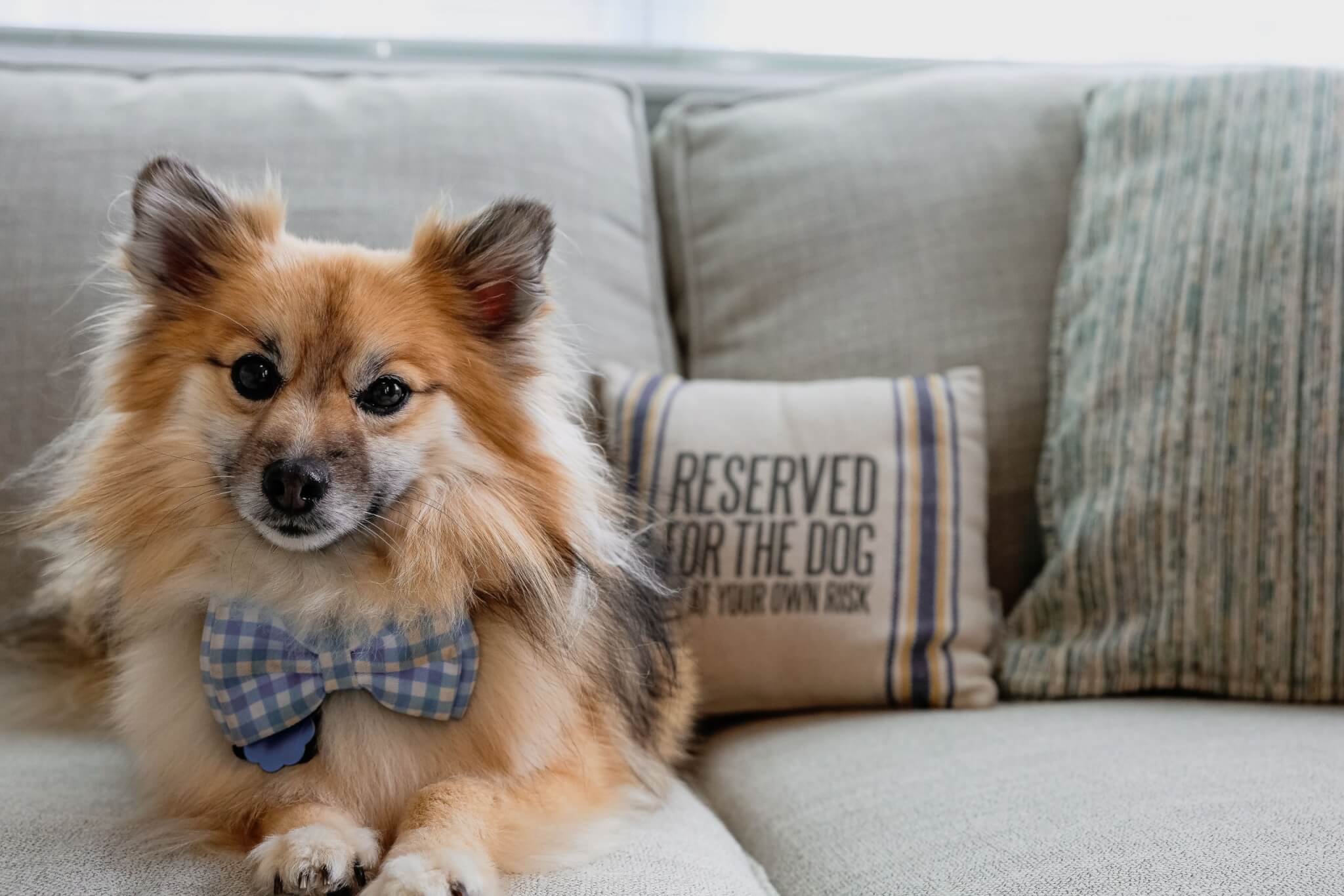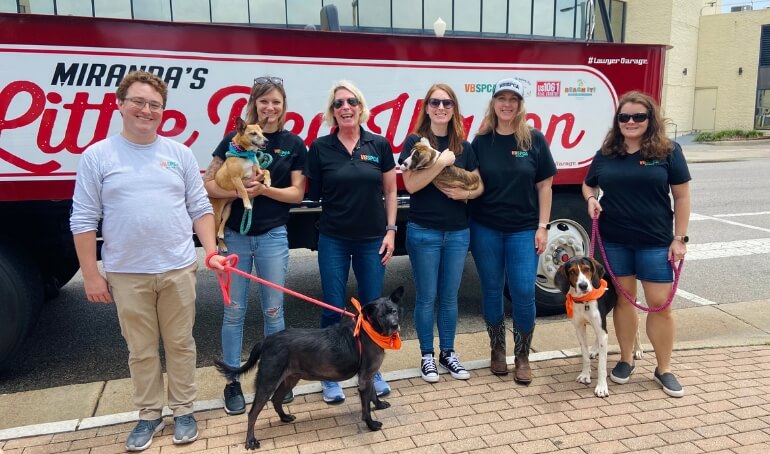
VBSPCA Goes Backstage at the BEACH IT! Festival
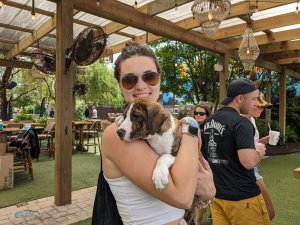 The inaugural BEACH IT! Country Music Festival kicked off with some special four legged friends. The Virginia Beach SPCA was honored to be part of Miranda’s Little Red Wagon donation drive at The Shack ahead of the festival’s opening on Friday, June 23, 2023.
The inaugural BEACH IT! Country Music Festival kicked off with some special four legged friends. The Virginia Beach SPCA was honored to be part of Miranda’s Little Red Wagon donation drive at The Shack ahead of the festival’s opening on Friday, June 23, 2023.
Despite the rounds of storms rolling through, country music fans stopped by to meet adoptable dogs and puppies, donate to the animals, and learn about the VBSPCA. Each person who made a financial donation or dropped off an item from the VBSPCA Wish List was entered into a raffle for two VIP tickets to the BEACH IT! Festival as well as an autographed copy of Miranda Lambert‘s new cookbook, “Y’all Eat Yet?”.
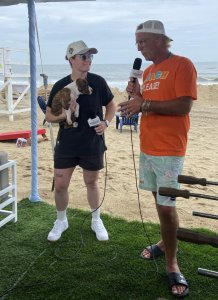
The donation drive was initiated by country artist Miranda Lambert’s MuttNation Foundation, which organizes Fill the Little Red Wagon donation drives at her concerts to benefit shelters across the country. US1061 – Real Country teamed up with Lawyer Garage to create a bus-sized ‘Little Red Wagon’ for this special event.
Following the donation drive, VBSPCA adoptable dogs went backstage to greet the crew and musical artists. Spud, a 12 week old Terrier mix, even got to make a special appearance with singer Lily Rose during a backstage interview. A big thank you to everyone who stopped by to support the VBSPCA animals!
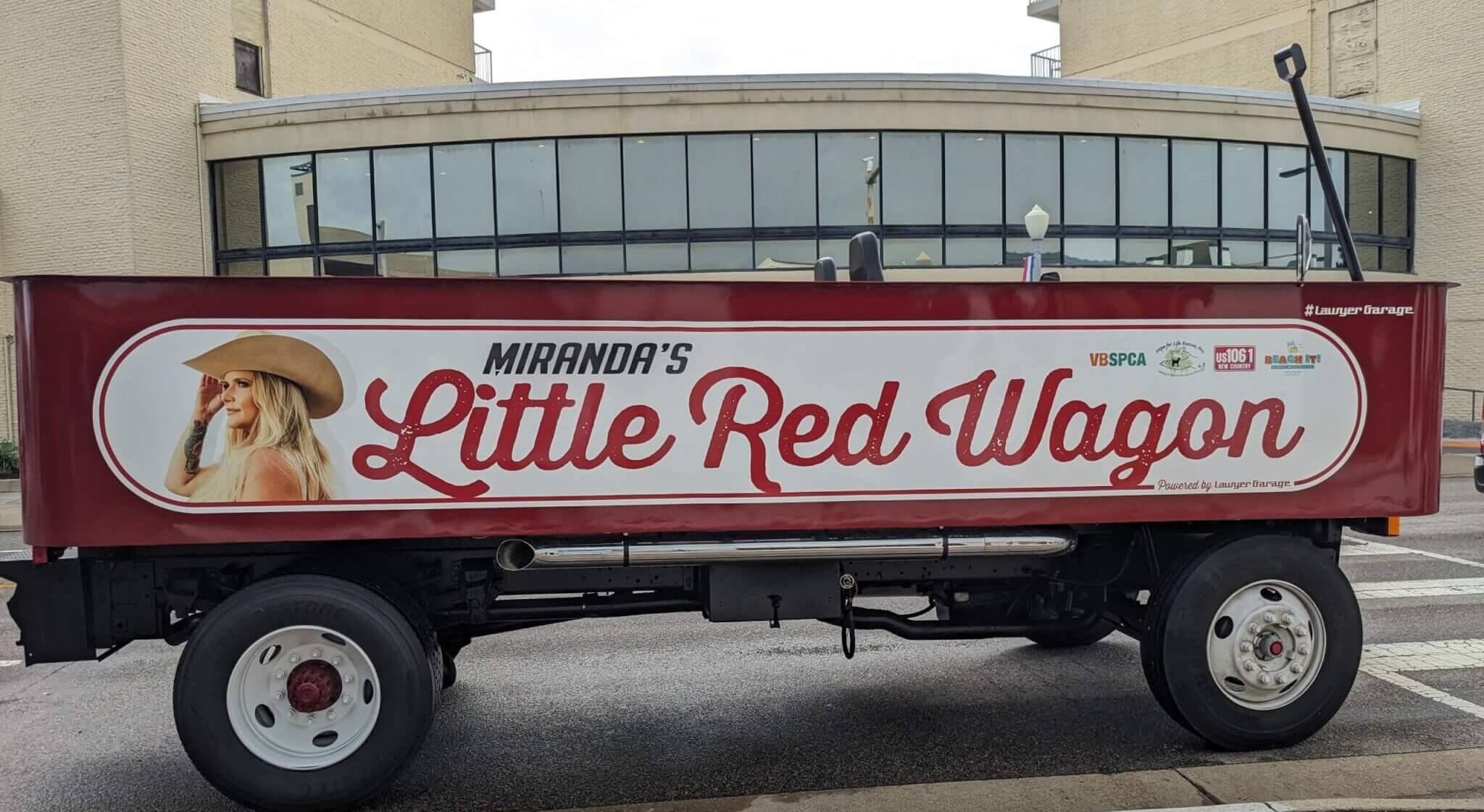
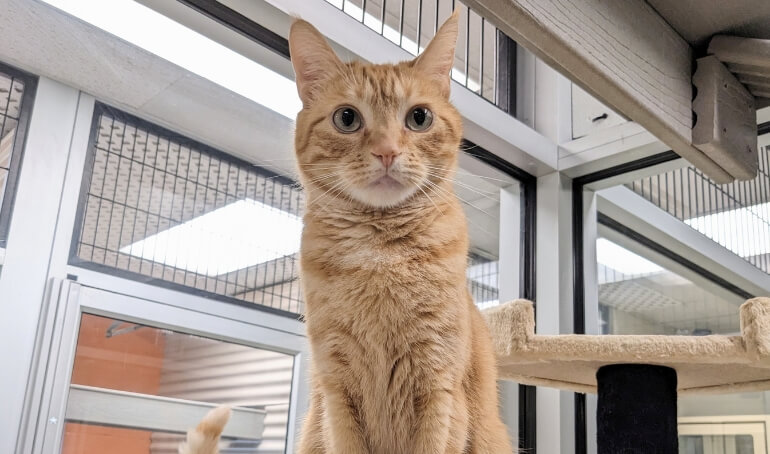
Behind the Scenes of the VBSPCA Cattery
Have you ever wondered what it is like to work at an animal shelter? Here at the Virginia Beach SPCA, we have more than 60 employees who connect people and pets. Our team members serve in a variety of roles, and each individual is an integral part of working towards our mission of ending animal suffering while increasing human compassion. This month we want to take you behind the scenes of the VBSPCA Cattery.
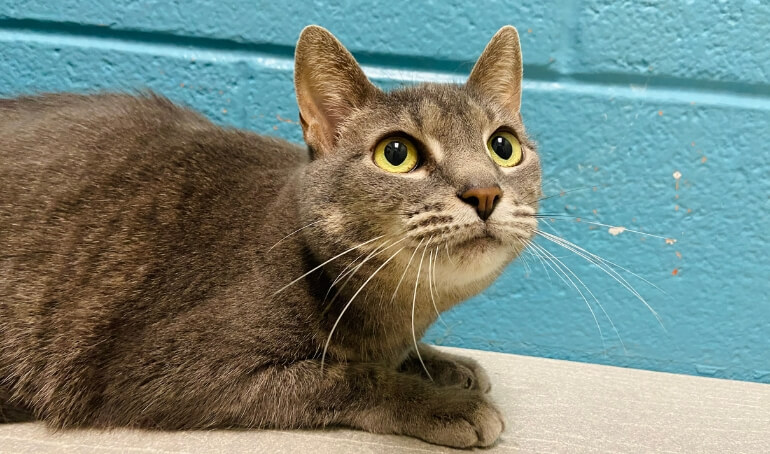
Happy Tails | Me Me
Every single animal that comes through our shelter has a story. Some are complex, many are sad, but all of them get better the minute they arrive at the Virginia Beach SPCA. Me Me was brought to the VBSPCA in September 2022 when her previous owner could no longer care for her. The sweet senior cat was very shy and was continually overlooked by potential adopters.
However, Me Me had a couple of very special visitors – Erin and her partner, Andy. They were initially unable to adopt but dropped in to visit her over the course of a few months. Me Me’s big day finally came in January 2023, when Erin and Andy officially adopted her and took her home after she spent four long months in the shelter. We recently caught up with Erin for Me Me’s full story.
How did you you know Me Me was the one for you?
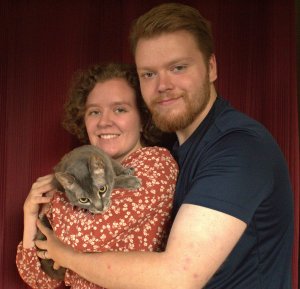 My partner and I used to visit the VBSPCA every weekend to get to know the senior cats as at the time we couldn’t adopt. The cattery staff would pick out a senior or shy cat for us to spend time with and help socialize. One weekend in early October 2022, we were asked to sit with a particularly nervous senior cat, which was Me Me. She didn’t let anyone pet her so we sat with her for about 40 minutes that first visit just talking to her, and she eventually let us pet her a little bit. Over the course of a few weekends, she started purring within 5 minutes of being with her and rolled over for belly rubs at each visit. She still hadn’t liked anyone else at this point and we knew she was meant to be a part of our family. By coordinating with the cattery staff, we were able to set her adoption date and bring her home!
My partner and I used to visit the VBSPCA every weekend to get to know the senior cats as at the time we couldn’t adopt. The cattery staff would pick out a senior or shy cat for us to spend time with and help socialize. One weekend in early October 2022, we were asked to sit with a particularly nervous senior cat, which was Me Me. She didn’t let anyone pet her so we sat with her for about 40 minutes that first visit just talking to her, and she eventually let us pet her a little bit. Over the course of a few weekends, she started purring within 5 minutes of being with her and rolled over for belly rubs at each visit. She still hadn’t liked anyone else at this point and we knew she was meant to be a part of our family. By coordinating with the cattery staff, we were able to set her adoption date and bring her home!
How is Me Me doing in the home?
Me Me is doing very well, cuddling tons and playing with all her toys. Even at the age of 12 she still gets zoomies!
What sort of activities do you do together?
We birdwatch out the window, and she loves chasing her toys around and pouncing on treats we toss to her.
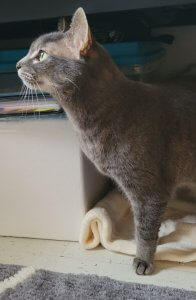 Does Me Me have any funny quirks?
Does Me Me have any funny quirks?
She doesn’t really meow much, but as she has gotten more comfortable, she chirps at us all the time. She is very silly and obsessed with rugs, rolling around [on them] while purring or using them as a scratcher.
How has Me Me enriched your lives so far?
Me Me has brought our family so much joy, from constant cuddles every night and morning to hearing her little paws shuffling around when she gets zoomies. She is such a sweet, silly, and loving member of our family and we couldn’t be happier to have her!
Why do you think people should consider adopting a shelter pet?
We think people should truly consider adopting from shelters as there are so many animals with different personalities that you can get to know to find the right fit. We really encourage people to look at senior animals when adopting; they can be just as fun and playful as any other pet! So many people overlook them, but we love our sweet senior girl so much!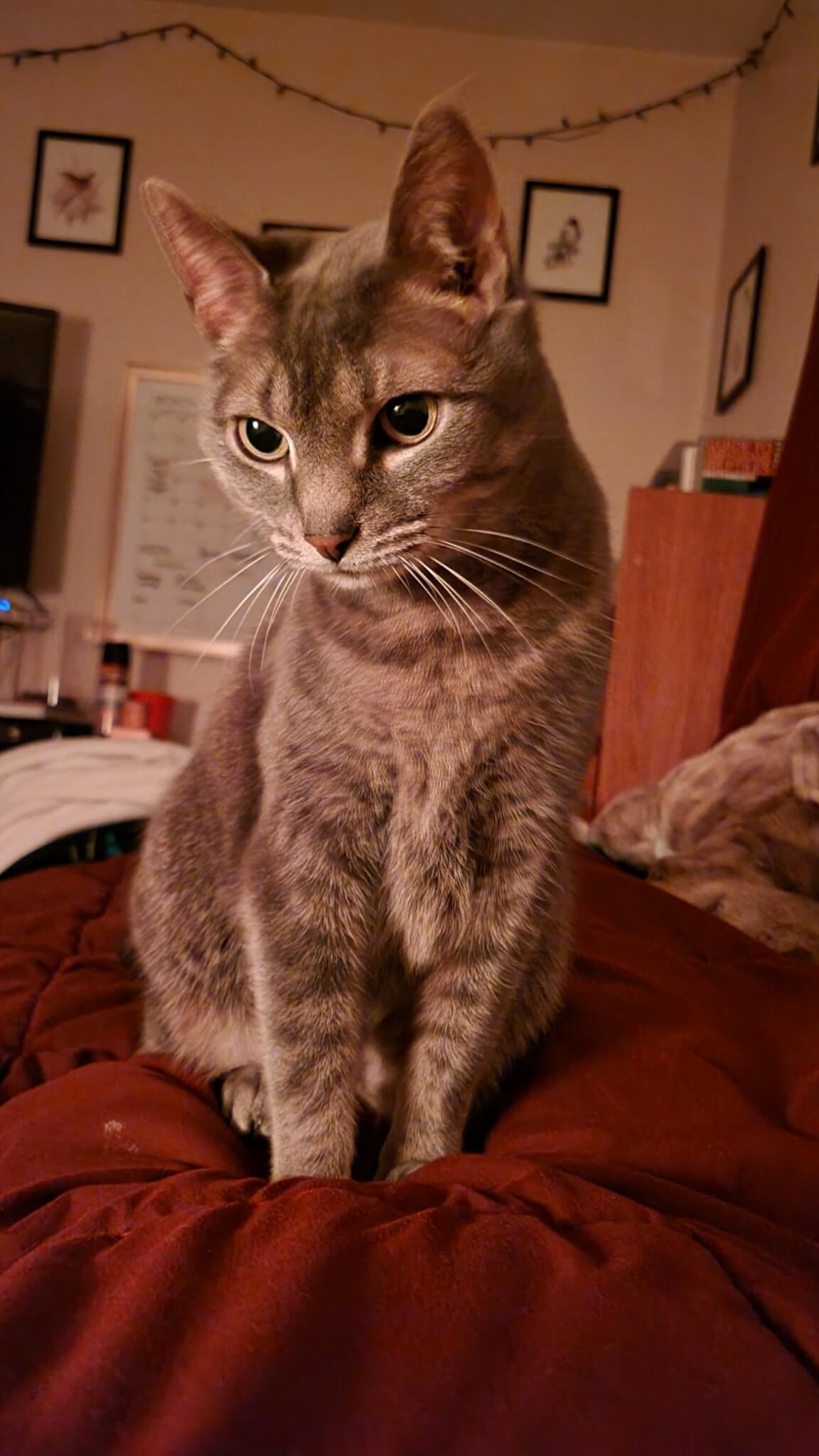
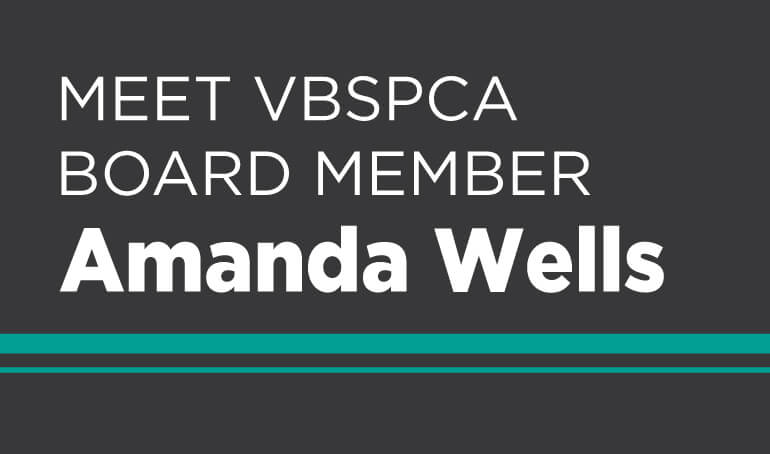
Meet VBSPCA Board Member Amanda Wells
Amanda Wells is passionate about helping others. Whether it’s people or animals, she is energized by making things better for those around her. Wells does both by serving on the Virginia Beach SPCA’s Board of Directors.
Wells first got involved with the VBSPCA as a volunteer. “Volunteering at the VBSPCA is very rewarding,” she said. “Volunteering allows you to get to know the animals and help get them adopted.”
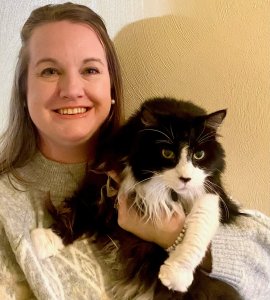 Now as a board member, Wells also shares her expertise in human resources to help the VBSPCA’s team. She is currently the Norfolk Botanical Garden’s Director of Human Resources. In addition to her extensive human resources background, Wells has 18 years of experience working with nonprofit organizations. She is extremely connected to the VBSPCA’s adoption services.
Now as a board member, Wells also shares her expertise in human resources to help the VBSPCA’s team. She is currently the Norfolk Botanical Garden’s Director of Human Resources. In addition to her extensive human resources background, Wells has 18 years of experience working with nonprofit organizations. She is extremely connected to the VBSPCA’s adoption services.
“I appreciate that the VBSPCA is such a resource to the community, from the clinic, animal adoption, the Pet Pantry, and more,” explained Wells. “When a person adopts a pet, they are saving a life.”
While Wells is quick to encourage others to volunteer at the VBSPCA, she also recommends attending its events. “They are fun and you meet other people who love animals,” said Wells.
We are happy to welcome Wells to the VBSPCA Board of Directors. It takes involvement from caring people in our community to make a difference in the lives of homeless animals!
If you are interested in serving on the Virginia Beach SPCA Board of Directors, please email Derby.Brackett@vbspca.com for more information.

2023 VBSPCA Lifesaver Award Recipient: Bill Campbell
Pets have been a part of Bill Campbell’s life for as long as he can remember. From his getting his first dog, Heater, when he was seven years old to the visits he now gets from his children and “grandpets,” Campbell has enjoyed the company of many animals over the years.
When asked how animals have changed Campbell’s life, he explained, “Having pets taught me responsibility and compassion, and provided the joy of companionship with another being who showed love and devotion.” Through his involvement with the Virginia Beach SPCA, he has changed the lives of many animals as well.
Campbell served on the VBSPCA’s Board of Directors from 2016 to 2022, when he transitioned to an honorary board position. Throughout the years he has shared his expertise in communications and been a sponsor of the organization’s events. He has also shared his artistic talents to raise funds for the animals by donating custom pet portraits for VBSPCA silent auctions. Additionally, Campbell was the man behind the drawing featured on the custom beer label for Second Chance Sour Ale, which was part of a photo contest and fundraising initiative launched in 2021 in collaboration with Smartmouth Brewing Company.
Campbell’s years of contributions to the VBSPCA will be recognized with the 2023 Lifesaver Award, which will be presented to him at the Wags and Whiskers Gala on Saturday, April 29, 2023. It is only fitting, since he has attended and provided financial support to the organization’s largest fundraising event for many years.
“As long as I remember coming, the Gala has been one of the major highlights of every season,” says Campbell. “The animals, the fun, the pride in supporting such a worthy cause.”
Campbell has been a dedicated ambassador of the VBSPCA in our community, spreading awareness of the organization’s service offerings. “What amazes me about the Virginia Beach SPCA is that it is far more than a pet adoption agency. Its dedication to animal health, humane education, affordable veterinary services, and injured wildlife rescue all contribute to its mission of eliminating animal suffering and building human compassion,” he says.
It is impossible for the VBSPCA to sustain its programs and services without committed and caring members of the community such as Campbell. While he shies away from credit for his part in saving animal lives, receiving this year’s Lifesaver Award affirms something Campbell has long known. “[This recognition] is an affirmation that working for something you truly believe in can prove highly rewarding. I don’t need an award to learn that lesson,” says Campbell.
“My involvement with the Virginia Beach SPCA has also allowed me the satisfaction of helping so many animals find loving homes, where I’m sure they will help develop the same values that animals taught me.” – Bill Campbell

2023 VBSPCA Compassion Award Recipients: Scott and Katie Taylor
There is a saying: like father, like son. In Scott Taylor’s case, that is especially true when it comes to his love of animals. From watching his father do much of the heavy lifting when caring for childhood pets to seeing his dad save ducklings from natural predators, Scott fondly remembers the compassion that both of his parents demonstrated to animals throughout the years.
Just one visit to the Virginia Beach SPCA fueled Scott’s own compassion, sparking more than a decade of service to homeless animals in Hampton Roads. He was invited for a tour and instantly agreed to join the Board of Directors. “After understanding the impact animals receive by the unbelievable people it takes to support the organization’s operations, I knew I had to get involved,” explains Scott.
Scott’s enthusiasm quickly spread to his wife, Katie, whose connection with animals began with her own childhood pets: ferrets and Doberman Pinschers. “Scott’s dedication to the animals and all involved at the VBSPCA inspires you to be active, help where you can, and do anything to support [the organization],” says Katie. “My compassion has only grown through the years.”
Since then, the Taylors have been constant champions of the organization. Their years of dedication to the animals will be honored with the 2023 Compassion Award, which will be presented to Scott and Katie at the VBSPCA Wags and Whiskers Gala on April 29, 2023.
On a personal level, Scott and Katie have sponsored, chaired, or volunteered at countless VBSPCA events over the years. The Taylors have also found ways for their businesses to support the organization. In addition to Taylor Construction’s longtime financial support as an Annual Partner, the company has helped out with facility projects. VA Valet is a staple at VBSPCA events, volunteering its valet and parking management services.
But perhaps the Taylors’ most meaningful connection to the VBSPCA is evident in their own home. “Katie and I have two amazing felines – Liv and Penny – who are loved by our family, friends, and colleagues as the ‘cool cats’ that have converted many of those who ‘only like dogs’,” says Scott. Katie adds, “It is hard to put into words the joy that animals and especially our two girls bring to me. There is love like no other from a pet, and we are all lucky to have them in our lives.”
When the Taylors found out they were the recipients of the 2023 Compassion Award, both described feeling humbled. Scott’s response clearly reflected the spirit of the honor: “When we are blessed with talents, time, and treasures, we are expected to benefit others – both human and companion animals.”
“Pets teach us important lessons. Responsibility, unconditional love, companionship, and compassion, just to name a few. Pets are some of our best friends, they always keep our secrets, they lower our stress level (most of the time), and they care for us as much as we care for them.” – Scott Taylor
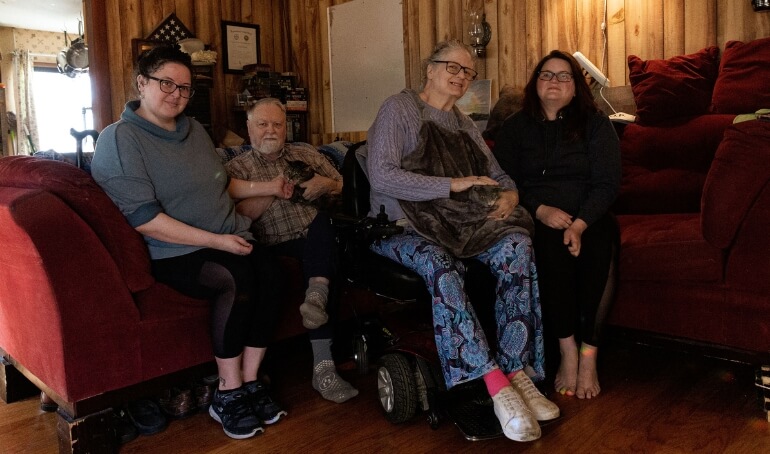
Happy Tails | Alanna
Every single animal that comes through our shelter has a story. Some are complex, many are sad, but all of them get better the minute they arrive at the Virginia Beach SPCA. Alanna was transferred to the VBSPCA in October 2022 from one of our local animal shelters as a young kitten. She was placed into one of our foster homes until she was healthy and strong enough for the adoption process. Aside from her time with her foster family, Alanna hadn’t had much interaction with humans and was very shy. Because of this, she wasn’t adopted out as quickly as some of the more social kittens.
However, Alanna’s status of longest kitten resident pulled at the heartstrings of one family. Sandy and her family adopted her in December. We recently caught up with Sandy to get an update on how Alanna is doing now.
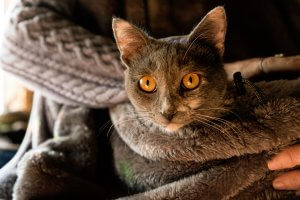 How is Alanna doing in the home?
How is Alanna doing in the home?
Alanna has adjusted beautifully to her new indoor lifestyle. We gave her some space in the beginning, allowing her time to explore the house and get used to her fellow rescue kitty, Elvira.
What sort of activities do you do together?
She loves to cuddle up to me in bed. Her happy purrs make my heart glow! I have a kitty pouch that she loves to lie in while we ride around in my power chair. Alanna likes to hang out with me in the kitchen. She and Elvira act as “quality control”, taste-testing what they are allowed.
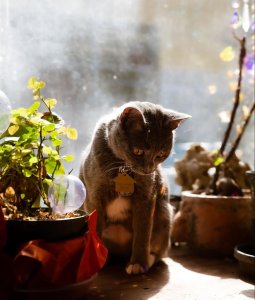 Do you have any funny stories to share from your time together?
Do you have any funny stories to share from your time together?
Watching her relationship with Elvira evolve has been quite amusing! It was a bit adversarial in the beginning, but then Elvira began to teach Alanna, who proved to be a very adept student. Now, she stalks Elvira, rushing out from under the sofa and stopping right in front of her. They touch noses as if to say “Tag! You’re it!”. Then Alanna runs away with Ellie hot on her heels!
How has Alanna enriched your lives so far?
There aren’t enough words to describe how happy she has made me AND my husband. He’s the only male in the house, so that makes him the Alpha of the “pride”. It’s quite funny! Alanna is our baby and we adore her!
Why do you think people should consider adopting a shelter pet?
Shelter pets are different. They all have stories; some good and some not. They crave love, attention and physical contact with someone they can trust not to let them down. I wish I could adopt them all! Shelter pets give unconditional love.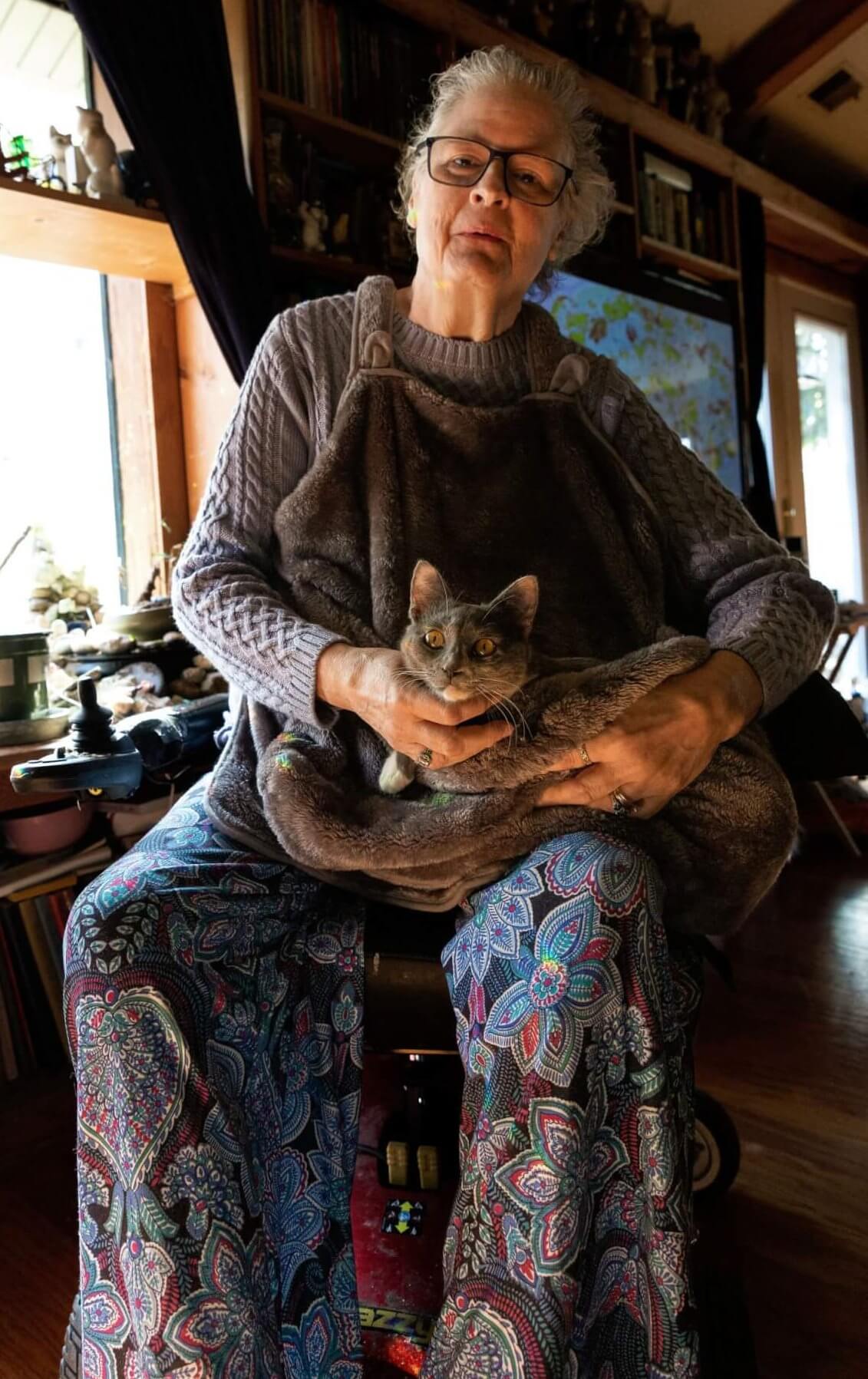
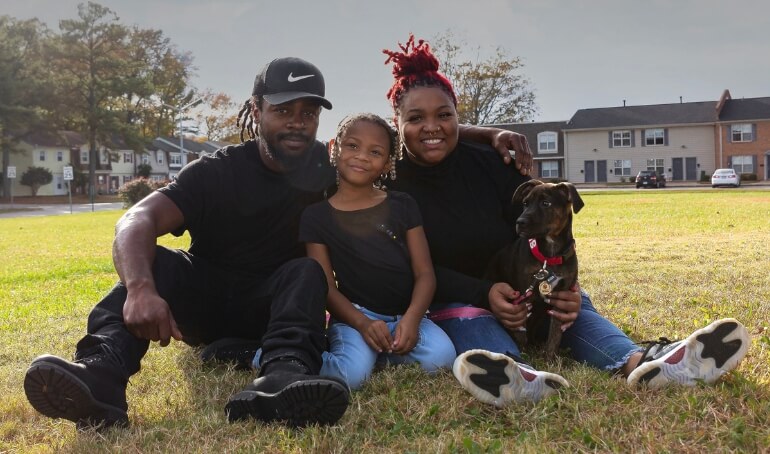
Happy Tails | Espresso
Espresso is one of two puppies from the Virginia Beach SPCA that has been selected for the 2023 Puppy Bowl on Animal Planet! In addition to being a famous puppy athlete, Espresso is also a beloved pet who fell in love with her family right here at our shelter.
Espresso was abandoned along with her 10 hound mix littermates in North Carolina in September 2022. They were alone on the side of the road, scared and without their mother at only six weeks old. The pups were taken to a local shelter before being transferred to the VBSPCA, where they received weeks of care before they were ready for the adoption process.
Once Espresso was ready for her shot at a forever home, it didn’t take long for her to catch the eye of Jazmine and her family. She was officially adopted last October. We recently caught up with Jazmine to hear more about Espresso’s home life before we get ready to cheer her on in this year’s Puppy Bowl!
How did you know Espresso was the one for you?
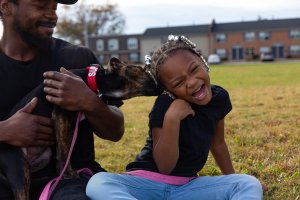 We decided we wanted to add a dog to the family so we went to the VBSPCA. Derrick [Jazmine’s partner] saw her first and instantly wanted to spend time with her. When we took her in the room, she instantly came to me and got in my lap. My heart melted and I remembered my family saying, your dog picks you, you don’t pick the dog. She jumped all over Cynia [Jazmine’s daughter] and Derrick too. I knew she was meant for us, but unfortunately there was a family who had applied to adopt her first. I was so nervous because we had fallen in love with her and there was a possibility we wouldn’t get to bring her home. Fate was on our side because the other family’s application fell through.
We decided we wanted to add a dog to the family so we went to the VBSPCA. Derrick [Jazmine’s partner] saw her first and instantly wanted to spend time with her. When we took her in the room, she instantly came to me and got in my lap. My heart melted and I remembered my family saying, your dog picks you, you don’t pick the dog. She jumped all over Cynia [Jazmine’s daughter] and Derrick too. I knew she was meant for us, but unfortunately there was a family who had applied to adopt her first. I was so nervous because we had fallen in love with her and there was a possibility we wouldn’t get to bring her home. Fate was on our side because the other family’s application fell through.
How is Espresso doing in the home?
Espresso adjusted well. She feels like the missing piece to our family. She brings so much joy, especially to our daughter.
What sort of activities do you do together?
We play outside a lot. Her favorite thing to do is play tag and tug-of-war or chase after Cynia and Derrick. She is super affectionate and loves cuddles and to be rubbed.
Does Espresso have any funny quirks?
Anytime she does something she’s not supposed to do she turns her head to the side and then turns her face up to ignore you. It’s hilarious because you can tell she understands that she’s not supposed to be doing something.
How has Espresso enriched your lives so far?
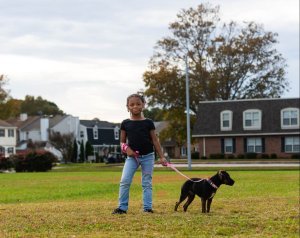 After a long day of work or school, Espresso always greets us with plenty of love and energy and excitement. She’s a joyful dog to be around.
After a long day of work or school, Espresso always greets us with plenty of love and energy and excitement. She’s a joyful dog to be around.
We are first time pet owners. One thing we learned is, just like babies, there is no manual. You learn as you continue to grow with your pet and y’all learn from each other. Be patient, be kind, and make sure your fur babies feel included and loved.
Why do you think people should consider adopting a shelter pet?
I think people should adopt from a shelter because, just like humans, we all need love. A lot of times I feel shelter pets are passed over but they just want to have a forever family.
Be sure to tune in to this year’s Puppy Bowl to see Espresso in action on Sunday, February 12th at 2:00pm on Animal Planet! You can also join us for our Puppy Bowl Tail-Gate Party to meet Espresso and our other pup star, Briscoe. Click here for details.
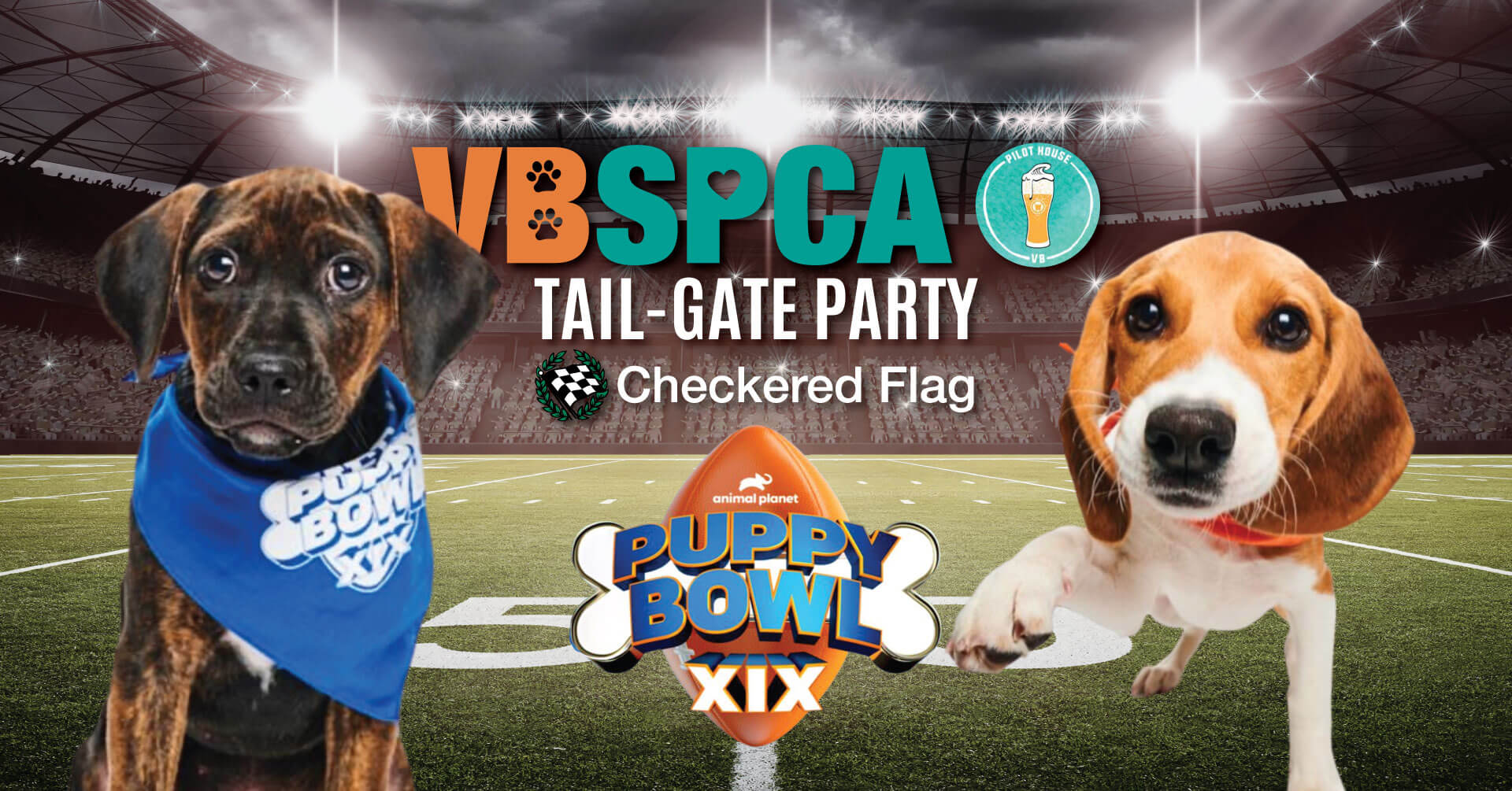
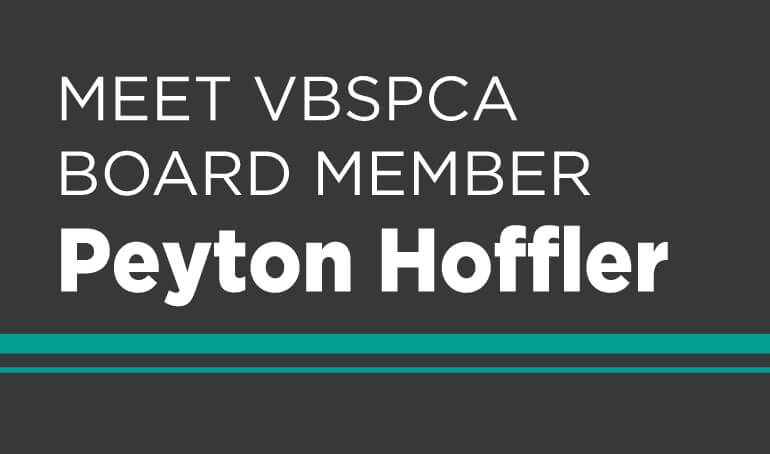
Meet VBSPCA Board Member Peyton Hoffler
Peyton Hoffler is no stranger to animal shelters. She started volunteering when she was in high school and eventually worked as a sales representative/adoption coordinator at a dog rescue in Los Angeles. Now she is taking on a new role in animal welfare: serving on the Virginia Beach SPCA’s Board of Directors. 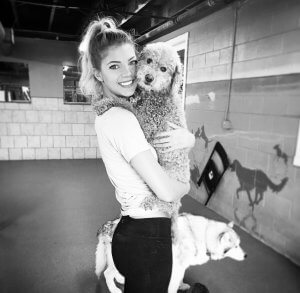 “I have always enjoyed being hands on helping the animals, and now I am at a point in my life where I can also be a financial support and help with creative fundraising ideas,” Hoffler said.
“I have always enjoyed being hands on helping the animals, and now I am at a point in my life where I can also be a financial support and help with creative fundraising ideas,” Hoffler said.
Additionally, Hoffler has experience working in the service and mortgage industries. While her focus now lies on starting a family, she makes sure to carve out time for her two passions: philanthropy and art.
“My goal in life is to do my best to even play a small role in eliminating animal suffering, and to do that you have to work to increase human compassion for animals,” said Hoffler. “We have to help the ones that can’t help themselves.”
Hoffler champions the many ways the community can get involved with the VBSPCA. From events to volunteer opportunities, she spreads the word to help us connect people and pets. “Helping animals and people is what makes me the happiest,” she explained.
We are happy to welcome Hoffler to the VBSPCA Board of Directors. It takes involvement from caring people in our community to make a difference in the lives of homeless animals!
If you are interested in serving on the Virginia Beach SPCA Board of Directors, please email Derby.Brackett@vbspca.com for more information.

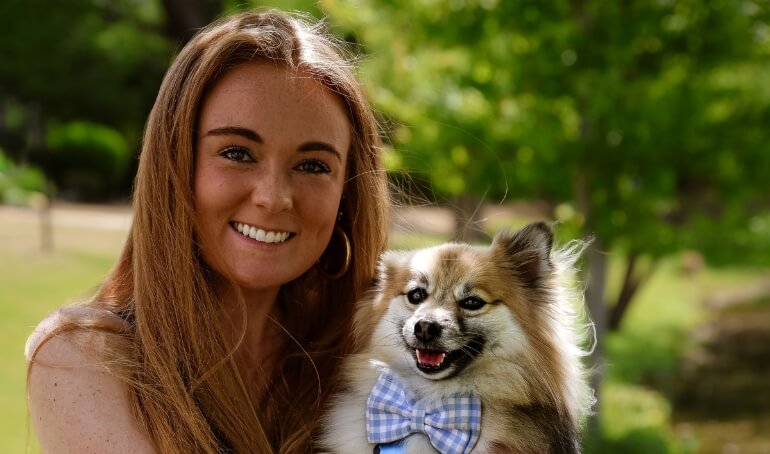



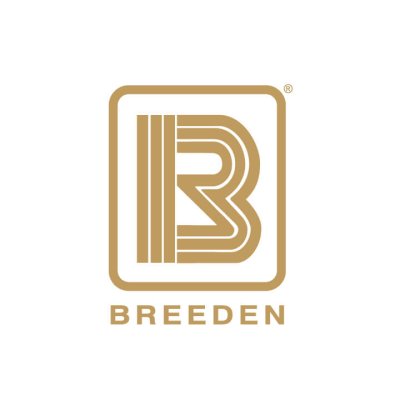

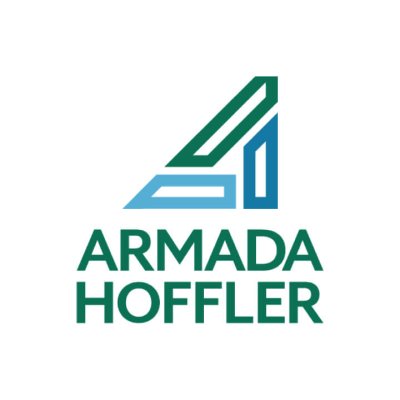













Last Updated: June 26, 2023 by vbspcaadmin
Happy Tails | Bentley
Every single animal that comes through our shelter has a story. Some are complex, many are sad, but all of them get better the minute they arrive at the Virginia Beach SPCA. Bentley was transferred to the VBSPCA from another shelter in June 2021. Previously the little Pomeranian mix had been chained outside with other dogs, living in filth. When Bentley arrived with a limp, the VBSPCA clinic team immediately examined him and determined he had been shot. There were buck shot fragments still in his leg, and the leg was broken. Our veterinarians amputated his leg, and Bentley was fostered by one of our staff members while he recovered from the surgery.
Despite living through years of neglect, Bentley was very friendly with humans. Once he was ready for adoption, his foster mom set up meet and greets with potential adopters. He immediately clicked with a young woman named Cat, who was ready to adopt a dog after living without a canine companion during her undergraduate program. We recently caught up with Cat to hear about how life with Bentley has been since she adopted him.
My sister, Melanie, was actually the one who found Bentley! She saw him online and thought that he would be a great fit! I was won over by the story of his previous life and was instantly head over heels for this little dog.
How is Bentley doing in the home?
Bentley has done exceptionally well since I brought him home! We have adopted a great routine in the mornings including a walk around the lake, then breakfast and coffee together (his breakfast and my coffee, of course) before getting ready for school!
Does Bentley have any funny quirks?
As boy dogs do when they go potty, he attempts to lift up his back leg. However, since he is down a leg in the back, he ends up walking on his front paws in an attempt to keep his balance!
How has Bentley enriched your life so far?
There is truly nothing like the experience of owning a dog! Their loyalty to stay by your side, the fun they have on walks together, and the excitement they show when you walk through the door is truly an experience like no other. Sometimes, one can feel small in this world and feel as if they have no power to make a difference – however, when you make the decision to adopt a dog, you have changed their life forever.
Why do you think people should consider adopting a pet with special needs?
I believe that adopting a dog with special needs is truly a privilege if one has the ability to do so. Having the patience to provide for a dog with special needs takes a certain “breed” and may not be for everyone. However, if one feels as though they are called to do so, it can be incredibly enriching to provide for an animal that may need a little extra help. From my experience, most dogs (and Bentley as well) have an incredible ability to adapt and flourish with just the added bit of help from their humans!
